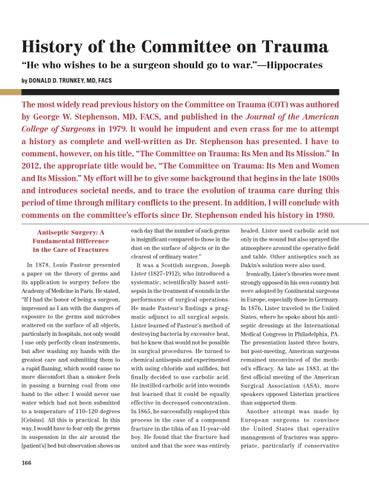History of the Committee on Trauma “He who wishes to be a surgeon should go to war.”—Hippocrates by DONALD D. TRUNKEY, MD, FACS
The most widely read previous history on the Committee on Trauma (COT) was authored by George W. Stephenson, MD, FACS, and published in the Journal of the American College of Surgeons in 1979. It would be impudent and even crass for me to attempt a history as complete and well-written as Dr. Stephenson has presented. I have to comment, however, on his title, “The Committee on Trauma: Its Men and Its Mission.” In 2012, the appropriate title would be, “The Committee on Trauma: Its Men and Women and Its Mission.” My effort will be to give some background that begins in the late 1800s and introduces societal needs, and to trace the evolution of trauma care during this period of time through military conflicts to the present. In addition, I will conclude with comments on the committee’s efforts since Dr. Stephenson ended his history in 1980. Antiseptic Surgery: A Fundamental Difference in the Care of Fractures
each day that the number of such germs
healed. Lister used carbolic acid not
is insignificant compared to those in the
only in the wound but also sprayed the
dust on the surface of objects or in the
atmosphere around the operative field
clearest of ordinary water.”
and table. Other antiseptics such as
In 1878, Louis Pasteur presented
It was a Scottish surgeon, Joseph
a paper on the theory of germs and
Lister (1827–1912), who introduced a
Ironically, Lister’s theories were most
its application to surgery before the
systematic, scientifically based anti-
strongly opposed in his own country but
Academy of Medicine in Paris. He stated,
sepsis in the treatment of wounds in the
were adopted by Continental surgeons
“If I had the honor of being a surgeon,
performance of surgical operations.
in Europe, especially those in Germany.
impressed as I am with the dangers of
He made Pasteur’s findings a prag-
In 1876, Lister traveled to the United
exposure to the germs and microbes
matic adjunct to all surgical sepsis.
States, where he spoke about his anti-
scattered on the surface of all objects,
Lister learned of Pasteur’s method of
septic dressings at the International
particularly in hospitals, not only would
destroying bacteria by excessive heat,
Medical Congress in Philadelphia, PA.
I use only perfectly clean instruments,
but he knew that would not be possible
The presentation lasted three hours,
but after washing my hands with the
in surgical procedures. He turned to
but post-meeting, American surgeons
greatest care and submitting them to
chemical antisepsis and experimented
remained unconvinced of the meth-
a rapid flaming, which would cause no
with using chloride and sulfides, but
od’s efficacy. As late as 1883, at the
more discomfort than a smoker feels
finally decided to use carbolic acid.
first official meeting of the American
in passing a burning coal from one
He instilled carbolic acid into wounds
Surgical Association (ASA), more
hand to the other. I would never use
but learned that it could be equally
speakers opposed Listerian practices
water which had not been submitted
effective in decreased concentration.
than supported them.
to a temperature of 110–120 degrees
In 1865, he successfully employed this
Another attempt was made by
[Celsius]. All this is practical. In this
process in the case of a compound
European surgeons to convince
way, I would have to fear only the germs
fracture in the tibia of an 11-year-old
the United States that operative
in suspension in the air around the
boy. He found that the fracture had
management of fractures was appro-
[patient’s] bed but observation shows us
united and that the sore was entirely
priate, particularly if conservative
166
Dakin’s solution were also used.
